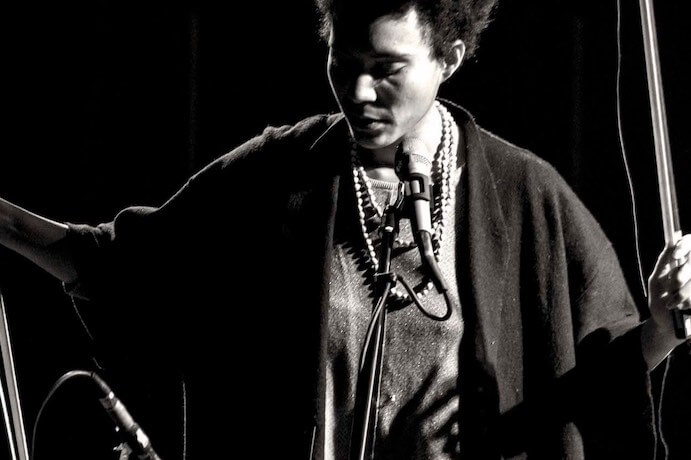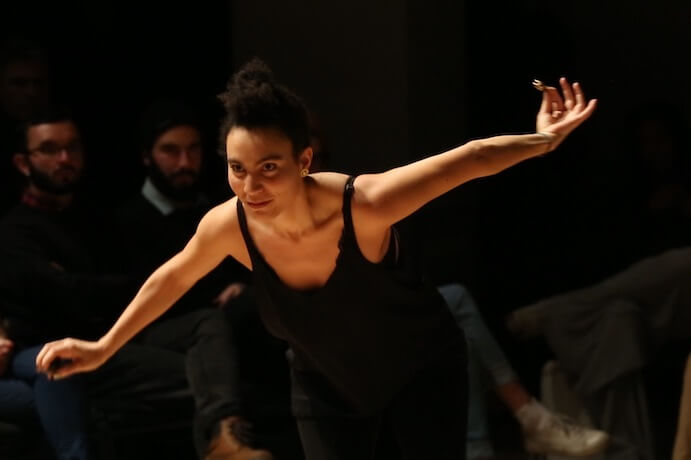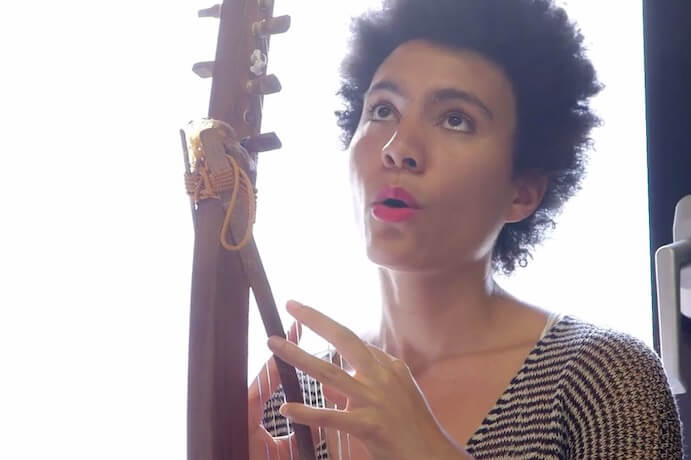Anaïs Maviel is a creator with a unique perspective who unites several disciplines compellingly. A vocalist, percussionist, composer, music director, community facilitator and teacher, her work also intersects with dance, theatre and performance art. New York based, she obtained a master’s degree in aesthetics from Paris Diderot University where she had a focus on “Afrocentric paradigms of Creative Music as utopian alternative politics,” and seeks to connect her work with postcolonial theory regarding relation, language and social transformation. She has toured North, Central and South America and Europe and has presented her work at Roulette Intermedium as a 2019 Van Lier Fellow. She has released several recordings as a solo artist and as part of the duo DIASPORA, most recently the Gold Bolus release in the garden (2019), recorded live at OBEY Convention in Nova Scotia (see I Care If You Listen’s review of the album and editor’s picks listing).
Anaiïs was recently announced as a recipient of the American Composers Forum’s ACF | create program, which awards funds for commissioning and performing new works by early career composers. Along with string quartet The Rhythm Method, Maviel will create listen to the rain, “a meditative chamber opera, an intimate conversation between morphing dynamic agents of this organism we call earth.”
Can you share some of your thinking at this stage about listen to the rain with respect to your cross-disciplinary work?
Working in a cross-disciplinary way reflects the multi-dimensionality that I experience in life and intent to express in art. As a seeker of common sources of creation, I came across cosmologies that point to vibration. Whether one has a spiritual or scientific approach, vibration is that subtle intentionality that generates sound, movement, and color, preceding manifestation and matter. I have been learning alongside artists from different mediums that approach cross-disciplinary artmaking as a way to connect a source to multiple and ever-changing commonalities. There are infinite ways to express some–infinitely complex and never graspable–thing. Thus, artistic mediums can touch various dimensions or perspectives on one topic, yet allow infinite layers of reality to unfold to our senses.
In that regard, listen to the rain is an invitation to recognize water as both one and plural, both inside and outside of ourselves, taking many forms and emanating different temporalities. Listening to the rain means letting our sense of hearing tell us about the multi-dimensionality of water, how hearing is a topography, and how connected the sense of hearing is with the other senses. In Chinese energetics–which inspire the methodology of this work–the five elements are dynamic agents connected to the human senses, and the sense of hearing corresponds to water.
I love music to be embodied. I experience art as a synesthesic experience, and music almost always reaches more than one sense. When I am physically involved in art, mediums don’t exist independently from each other. I am hoping that listen to the rain can convey to the performers and the audience that vibratory relatedness beyond the music–a music which will hopefully make sensible some of the many reflections of human liveliness that water brings evaporating up, raining down, and flowing around towards oceans.

Anaïs Maviel–Photo by Cameron Kelly Courtesy Issue Project Room
All four members of The Rhythm Method are composers themselves. How do you envision the collaborative process complementing your own ideas?
I have been very touched and inspired by the way the members of The Rhythm Method write for each other and for themselves. I find their process-based composition style special because it takes roots in a kind of sisterhood. One aspect of what one could call feminine musicality–although I want to acknowledge all identities and their open-endedness–is that ability to reveal collective coherence from deep listening (with and without referencing Pauline Oliveros here). When The Rhythm Method improvise together, each of their composer minds fuse into a collective intelligence, creating a multi-layered organism with a collective intuition that I find brilliant. I resonate with this organic way of bringing music together: collaboratively with the canons of string quartet music, yet born in a patriarchal society.
The music of The Rhythm Method sounds syncretic to me, as in a creolized era of culture integrating all layers of history in one’s aesthetics. To the extent that intuitive knowledge found a seat at the table of erudite music, I am also interested in exploring composition free from the concept of authorship, as my musical upbringing was based on oral transmission, like most knowledge women have passed down to our generations. Although each composer’s voice is distinct, the sound of The Rhythm Method overarches any piece they perform. That ensemble creative power is a very precious ingredient for cooking this new piece together. There is a lot to experiment with in an ensemble of women composers with more than one foot stepped outside of hegemony.
Can you talk about the direction of your musical development, including the process of discovering your vocal/instrumental practice and incorporating movement into your performances?
I grew up with a composer, librettist, performer, scholar, healer, and choreographer Haitian mother. We sang, played, and danced together lots. I learned about performance alongside her, singing harmonies to her songs and playing small percussion. Earthly, political, and spiritual matters were always braided into the music I grew up with.
Thankfully, as I developed creatively and realized I could turn into anything I wanted, to serve creation. I had been a disembodied performer for a long time, growing up an Afro-descendant woman in a Euro-centric, patriarchal cultural context. I needed an instrument in order to become independent in developing my creativity. I picked up the surdo, which I had been playing in a Brazilian percussion ensemble, and decided that it would become a ground to explore my voice. The surdo has this tonal consistency and overtone lushness that allowed me to get lost melodically and yet fall back in place. Thus, I developed a double personality in music, like an earth-drum/sky-voice relationship. I usually use musical instruments to ground the rhythm or tone so that the voice can reach the ether. That relationship has been a way of studying of the vocal instrument, especially in the areas of overtones, rhythm, mode, and harmony.
Movement is also a way of study for me, as I’ve come to realize my body is the instrument and that vibration is not only audible but also sensible, elliptic, collapsible, and reciprocal. Movement is an extension of sound. As my solo practice has generated conversations around vulnerability and the courage to be somebody else, it felt natural for me to go towards dance. I hope that, as some audience members have told me they were no longer afraid to sing, some will no longer fear their own “erotic power,” to quote Audre Lorde, that is to say, their capacity to experience joy from the depths of their bodily existence and to trust the contagiousness of pleasure in playing.

Anaïs Maviel performs her sound, text, and movement piece “Legba Swaying”–Photo by Michael Lucio Sternbach
What does being a community facilitator and teacher require of you as an artist, and what does it give back?
That is a good point for me to excavate, as I have been torn about how to title my activities. The expression “community facilitator” came to mind as I was looking for an alternative to “healer” because, as my dear friend and collaborator Melanie Maar once said, to call oneself an artist and a healer is kind of redundant. Art heals, certainly. How though?
I value oral transmission in the process of sharing music: I like to perform, and I like to learn and teach, as well. Vibration can feel abstract to some, but when we are gathered around music and something happens–that thing every artist, mystic, or iconoclast runs after–when what Albert Ayler calls the “holy ghost” appears, most of us will know it instantly. To me, the work I do is to facilitate this availability, sensibility, awareness, and reverence to that thing, which will work itself through our systems and expand our lives, individually and collectively in the same event. I find myself making people sing a lot, whether I write, perform, or teach music. I am inclined to join voices to learn about the power of connectedness in embodied sound, to learn from the above and the below. I guess in terms of exchange, I feel that I am required to keep my ego well tamed, so that there is space for each one to come through in whatever I facilitate. I receive in exchange the thrill of going places with sound.
Anaïs Maviel – Bleu Blanc Black – RBF NYC 2019 from Resonant Bodies Festival on Vimeo.
While there may be gradual progress towards utopian values in the arts, the burden of labor—artistic or otherwise—is still on underrepresented groups. What do you need to see from arts organizations that may aspire to multiculturalism and decolonization by way of programming your work?
Thanks for asking! I think this series of questions is a great start–communication and sharing points of view being a great way to grow out of colonization. I really appreciate the interest that has been given to my work in the past year from various organizations. I am aware of this delicate spot I sometimes fill, which is both of a token and of a creative person whose perspective takes root in an overwhelmingly underrepresented multitude. This grants me with a responsibility to participate in the ever-evolving bridging of creolized culture with a more classic–and unfortunately classist–understanding of music. As a scholar, I hold tools to make my practice intelligible to the “happy fews,” a club of which I’m a part, and I hope that folks from various levels of education can be encouraged to bring their work and vision forth without fear of being judged based on their agility with Western codes.
Organizations/Institutions who are looking at decolonizing their programming and aspire to multiculturalism should embrace intuitive knowledge and expose their decision-makers to the brilliance of post-colonial creation, which is resonating in the art of every person who is connected and aware of the many layers of displacement that are feeding their expression. Independently from the question of privilege, their art participates in a creolized culture, which is multiple and of the present.
In the context of colonization, Edouard Glissant defines “opacity” as the right of indigenous people to exist outside of the colonizer’s fantasies and interests, and yet to be respected. Compassion–an essential ingredient to build ethics–is the ability to feel what the other feels without having walked in their shoes. Thus, the demand for transparency often claimed in activist communities and organizations, can threaten the precious trust equilibrium every ethical relationship builds itself off of (think of “assuming good intention” in non-violent communication). The right to opacity refers to that ability to relate without understanding, to cooperate without controlling. Out of trying to understand the other, we often fit them in our preconceptions and miss the opportunity to truly learn from each other.
In a post-colonial context, I find the way an organization (that holds financial and decision-making power) approaches those defined as other is important. This starts with unpacking the power structure that lies behind this difference. Other than who, and how? What are we projecting on one another, and how do we want to relate? Do we have a certain idea of the authenticity of one another? Stuart Hall provides tools to deconstruct our expectations on the so called black experience and the myths of single root identity. What do we expect from the other, and what should they want?
I wish that art organizations would embrace the complexity of the post-colonial, creolized conundrum and let go of the haste to assign and claim identities. I believe that allowing the unknown to inform an outreach process is a sure way to expand one’s ability to relate free from political agendas that lead to overlooking content and quality of the art we bring about.
To me, decolonizing starts with acknowledging the uniqueness and opacity of every being, which is what we all have in common. I think the Northern American conversation around inequity is polarized by racial ideology, and unfortunately traps us in binary thinking. Race, gender, and disability are important topics to be deconstructed but should not cast a shadow on the systems that capitalize on difference–the immersed part of the iceberg. In my opinion, the ideologies that keeps us apart from each other are the ones that hold systemic oppression together, and we must examine and update our mindset before running after results. When talking about underrepresented groups, I think about 90% of the human race who can’t eat properly, can’t read, and don’t have human rights. I think about how I can use my privilege to open more cracks of this monster structure in an empowering way for myself and for others in the same event. I believe this can be done by developing collective intelligence, rhizoming all of our privileges and differences with purpose to solidify the net of interdependency we live on in the most sustainable ways possible. This sounds like utopia: Imagining new ways of togetherness–that’s what we’re here for!




















